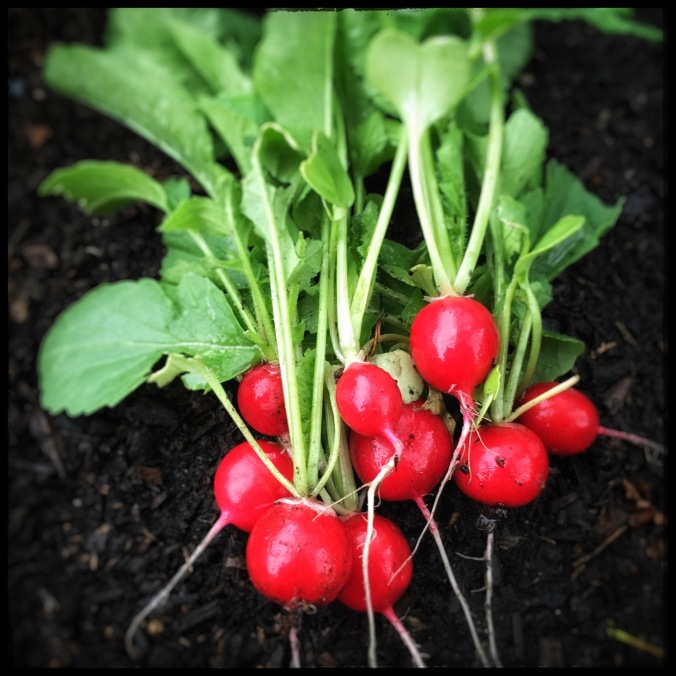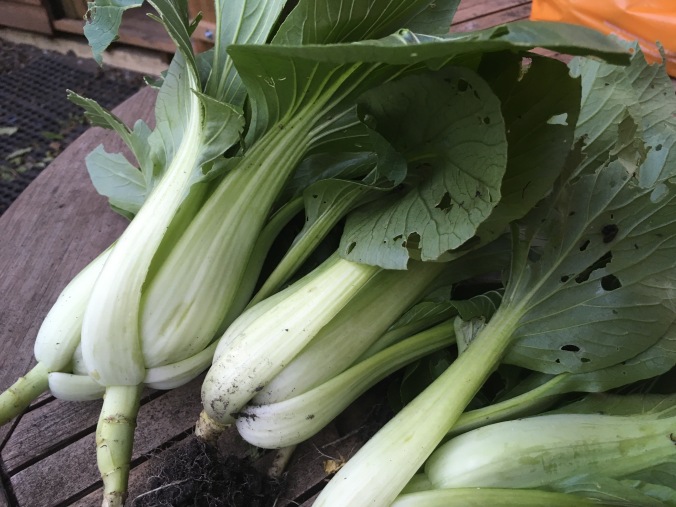Or what we learned in our first year on the plot.
In no particular order:
1. Don’t over plant

Beets packed in with not much space to get in to harvest and weed
In a flower garden over-planting may help, on some occasions, to give you a better display. But vegetable plants need their space.
The Quest for Veg plot is not quite a half size plot. So, conscious of our limited space, we were tempted to try to squeeze things in. But our aubergines were swamped by the courgettes and potatoes we planted too close to them, and they produced hardly any fruit. Similarly, the radishes we were growing in our raised bed were overtaken by a pumpkin and either bolted or failed to grow.
This year we will give things a bit more space.
Have you been tempted to “pack them in” on your plot? How did you get on?
2. Make room for paths
This is linked to the above resolution – we didn’t leave enough space to get around our plot. This meant most of the plot was a wheelchair no-go area. It also made harvesting and weeding difficult because we couldn’t reach things easily.
This year we’re going to think about how we can access the plants when we put them in.
We have been looking at the possibility of raised beds to make things easier not only for us but also benefit the plants. But we need to figure out how to do it and how to do it affordably. We are open to advice on this subject to add to our deliberations.
3. Woodchip breaks down really quickly

Our woodchip delivery
The woodchip we put down on the mypex made a great path but it’s already rotting down. We need to sift it so we can compost the dark crumbly stuff and place the undecomposed material back on the paths, along with some more fresh chippings.
We were surprised by how quickly the woodchip broke down. This might be because it came from one tree (Weeping Willow – Salix Alba) and that wood may decompose faster than other woods. Or it could be something to do with the shady nature of our plot.
But it has been incredibly useful to have a mud free area of the plot where we can park a wheelchair or buggy. So refreshing this path and building more is something we will do in 2018.
4. Weed, weed, weed
We didn’t get many parsnips which was probably because they became inundated with weeds. The seedlings are hard to identify when they’re very tiny. So, I may or may not have weeded out a few of them by mistake (I still say the evidence is circumstantial!) but as a result of a (very small) bare patch, I was banned from weeding that area.
I think the plan was to let the parsnips develop so they were easier to identify and then begin weeding in earnest. But, partly because there were so many other jobs to do on the plot, that didn’t happen and the weeds took over. We may yet discover a crop of parsnips when we clear that area. We shall see.
Similarly, part of our onion bed got a bit weedy because it was difficult to get to without risking stepping some of the other onions (see 2 above).
This year, we will keep on top of the weeding and accept that if one or two seedlings get weeded out by mistake, it’s better than losing the whole crop!
5. Harvest tomatoes while they’re still green

We had to harvest the whole tomato crop when we were hit with the blight, and the majority were still green
We were forced to harvest our tomatoes early because we were hit by late blight. Some fruits were red, or going that way, but there were an awful lot of green tomatoes to deal with.
Of course we made green tomato chutney. That goes without saying. We also pickled a lot of the cherry tomatoes. This was super easy – we just sliced them in half, and popped them in a jar with pickling vinegar, dill and pepper corns. They looked like fabulous little green jewels and tasted great. Both of these made great Christmas presents, too.
But, searching around for other creative ways to use green tomatoes, I discovered an amazing roasted green tomato pasta sauce – check it out. Don’t be put off by the long roasting time – at least an hour and a half – that’s where the magic happens, giving the tomatoes a charred and gloriously sweet flavour. I suggest cooking this sauce in large batches and freezing the extra.
This sauce only seems to work with green tomatoes. When I started to run out of green, I did try mixing in a few that were turning red, but the taste wasn’t as good – it became too sweet.
This year, I will harvest green tomatoes to make this sauce.
6. Grow more radish

Radish: scarlet globe
I cannot overstate how surprised we were to discover we love radish.
We thought we hated them but Andrew planted some anyway. Our first crop was scarlet globe, which had a creamy, only slightly peppery taste – nothing like the radish we both remembered from our childhoods. We loved them and discovered that they’re also great roasted.
But after that first crop, we had problems producing more – some bolted, others were overtaken by pumpkins (see 1 above). But this year, we will try again.
7. Grow lots of pak choi

Our snails also like our pak choi!
While not as earth shattering as 6 above, this is still sufficiently groundbreaking to significantly change our planting plans.
We’d both only ever had pak choi in Chinese meals. But chopped and pan fried with a little garlic, they make a delicious side dish which can accompany lots of things.
They seem easy to grow, don’t take long before they’re ready to be harvested and, by all accounts, can be sown throughout the year.
What more could you ask for? Well, a few more recipe ideas, perhaps. So, if you have any thoughts on cooking, or indeed growing pak choi, please let us know.
This year we will grow much more pak choi.
8. Plant fewer courgettes

A small selection of our courgettes
We got over enthusiastic when we chose our courgette seeds, buying several varieties and then acquiring more from the front of magazines. We tried seeds from all of them. And, once you have nurtured a seed and produced a tiny plant, well, you have to plant it out don’t you?
Actually, this was something we did with all our seeds – acquiring and sowing an abundance, then feeling compelled to plant them all out. But the courgettes were super productive which meant we felt the consequences more keenly. We ended up with about 14 plants (it may have been more) and there are two of us.
Every visit to the plot produced bags and bags of them. We were eating courgettes in every meal, we gave them away, taking trolley loads to the vegan restaurant at the end of the road. And still we had piles of them in our kitchen. It was an unstoppable tidal wave of produce worthy of a Hollywood epic.
We will definitely grow them again – they are tasty, versatile and easy to grow. But this year we will limit ourselves to two, maybe three, plants.
9. Sort out a watering system for our builders bags

Our builders -bag raised bed under construction back in February 2017
We discovered that our builders-bag raised beds dry out quickly. This was not so much of a problem with the smaller bags, but the large bags need a lot of water. We’ll either need to line them with something, or work in organic matter, or both.
We’re planning to put in a watering system this year, so hopefully that will help, too.
10. Plan for hardening off

Our plants spent too long hardening off under the tunnel cloche
We need to get better at planning in time for hardening off our plants.
Last year, we left things hardening off under our tunnel cloche too long, which created problems keeping the plants healthy, watered and slug free.
Since our key time for working on the plot is weekends, we need to make two consecutive weekends available – the first for transporting the plants from greenhouse to plot and putting them under protective cover to harden off, the second to plant them out.
So, that’s the next step. Create planting plans (and stick to them!).
Roll on 2018!
There was not enough water for the second crop of radish the same happened to mine. Love the info x Pat
LikeLiked by 1 person
Thanks for your feedback, Pat
LikeLike
Reblogged this on Site Title and commented:
Excellent ideas, more weeding, less courgette!
LikeLiked by 1 person
Great! Thanks 🙂
LikeLike
Your post made me smile. “And, once you have nurtured a seed and produced a tiny plant, well, you have to plant it out don’t you?” that’s so me! Last year I did that with tomatoes: I sowed some…. they grew quite leggy so I sowed some more but – and that’s an important but – I couldn’t bring myself to getting rid of the first ones so I re-potted them. In the meantime I had discovered a great site specialising in… tomato seeds so I had to try… I gave away about 30 plants and I still managed to cram over 40 in my small garden!
LikeLiked by 1 person
Hope you had a great crop! Thanks for your comment.
LikeLike
Some people suggest sowing radish mixed with parsnip seeds so when the radish germinate really fast and the parsnip take their sweet time; the radish mark out the rows and you know where the weeds are. The radish roots will grow fast and you harvest them all long before the parsnips need the room and are ready for harvest.
I also grew too many tomatoes this year and cant bear to throw them out so I will donate them to the local community garden and only keep what I can fit in (probably still more than I need though)
LikeLiked by 1 person
Great tip! Thanks for sharing!
LikeLike